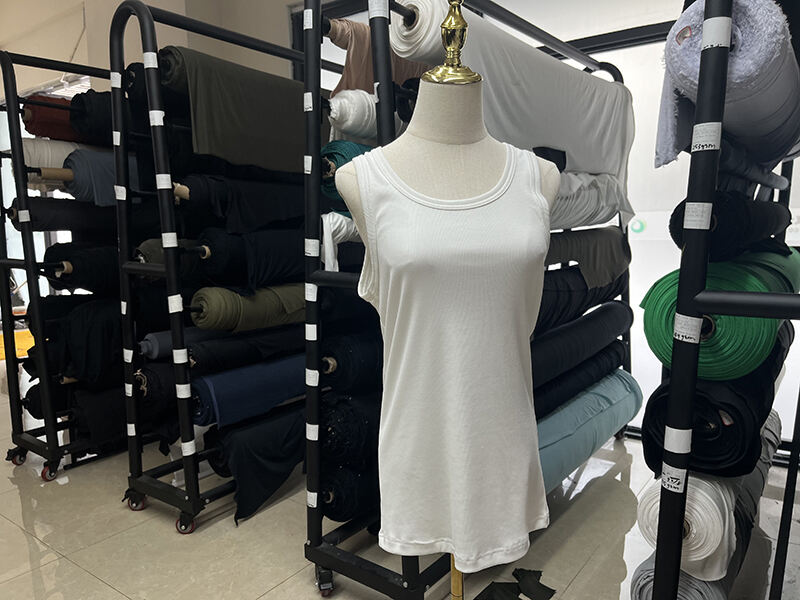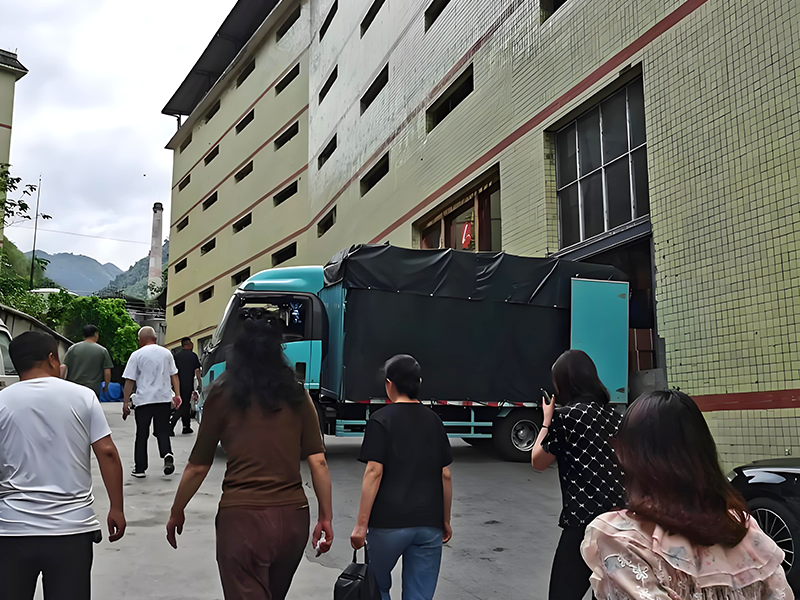Tre. Một từ đơn giản. Tuy nhiên, nó mang theo hàng ngàn năm trí tuệ nhân loại và một cuộc cách mạng âm thầm trong ngành dệt may hiện đại. Đó không chỉ là thứ dùng để nuôi gấu trúc hay xuất hiện trong những bức tranh Á Đông thanh bình. Tre là câu chuyện về sự sinh tồn, khả năng thích nghi và giá trị sử dụng lâu dài. Từ những công cụ cổ xưa đến những tấm vải mềm mại nhất, hành trình của tre song hành cùng hành trình của chính chúng ta. Cẩm nang này đi thẳng vào vấn đề: hiểu rõ quá khứ sâu xa của tre là chìa khóa để đánh giá đúng hiện tại mạnh mẽ của nó, đặc biệt trong thế giới đang bùng nổ của các loại vải bền vững.
Tình bạn bền vững của Tre: Lịch sử của Sự sinh tồn và Đổi mới
Nhìn lại. Con người, qua bao thế kỷ, đã xem tre không chỉ là một loại cây. Họ nhìn thấy khả năng. Sự phát triển nhanh chóng và sức mạnh tự nhiên khiến nó trở thành lựa chọn hàng đầu cho xây dựng. Nhà sàn. Cầu cống. Những công trình đơn giản giúp che mưa. Dụng cụ để săn bắn. Vũ khí phòng thủ. Công cụ làm nông nghiệp nuôi sống gia đình. Tre luôn sẵn có, chờ đợi. Sự dẻo dai của nó là hình ảnh phản chiếu sự sinh tồn của con người nguyên thủy.
Nhưng tre không chỉ liên quan đến lao động nặng nhọc. Nó còn tượng trưng cho tinh thần. Ở châu Á, nó trở thành một biểu tượng. Trường thọ. Bạn thấy điều đó qua những thân tre lâu năm. Sự kiên cường. Nó uốn cong trước gió nhưng không gãy. Trung thực. Thẳng tắp, từng đốt rõ ràng. Khiêm tốn. Bên trong rỗng, sẵn sàng được lấp đầy. Nghệ sĩ vẽ tranh về nó. Thi nhân ca ngợi nó. Nó mang lại bình yên. Kết nối con người với mặt đất. Một mối liên kết sâu sắc, âm thầm.
Trái Tim Vương Quốc Tre, Cái Nôi Của Văn Minh
Trung Quốc. Hãy gọi đó là "Vương quốc Tre". Đó không chỉ đơn thuần là một cái tên; đó là lịch sử được khắc ghi trong từng thân tre. Hàng ngàn năm qua, tre chính là cuộc sống. Người ta làm giấy từ tre. Không chỉ là giấy, mà là một cuộc cách mạng. Ý tưởng có thể lan truyền. Tri thức có thể được phổ biến. Hãy nghĩ về điều đó: khả năng viết lách, chia sẻ câu chuyện, truyền lại trí tuệ – tất cả đều nhờ có tre. Bề mặt trơn nhẵn và sợi tre chắc chắn khiến nó trở nên lý tưởng.
Âm nhạc cũng bắt nguồn từ tre. Những cây sáo và ống tiêu. Chính là âm thanh của nền văn hóa. Đồ nội thất được tạo hình. Rổ được đan lên, chắc chắn và nhẹ nhàng. Tinh xảo. Hữu ích. Cuộc sống hàng ngày được xây dựng bằng tre.
Sau đó, những thách thức lớn hơn đã đến. Đó là nước. Ruộng lúa cần nước. Làng mạc cần nước. Tre, với khả năng chịu nước tự nhiên của nó, trở thành ống dẫn nước. Nó trở thành một phần của hệ thống thủy lợi. Thông minh. Đơn giản. Nuôi dưỡng sự sống. Các bác sĩ đã sử dụng tre. Thuốc được làm từ lá và rễ của nó. Nó chữa lành. Nó mang lại sự dễ chịu. Và tất nhiên, là trong nhà bếp. Măng tre. Thực phẩm. Hương vị. Nguồn dinh dưỡng. Từ những công trình kỹ thuật lớn lao cho đến bữa ăn đơn sơ hằng ngày, tre là tất cả mọi thứ. Nó đã định hình nên một nền văn minh.
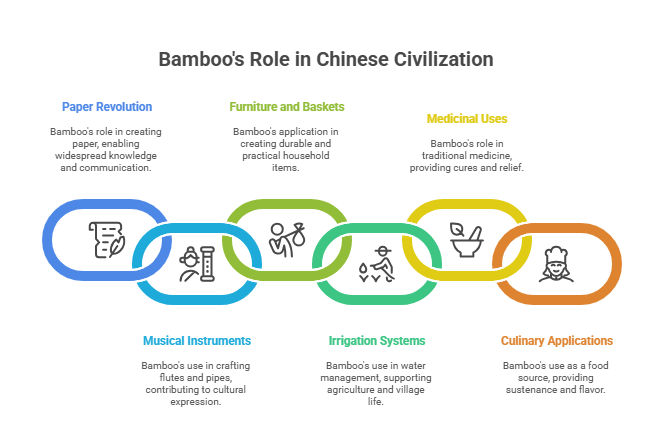
Sự Phát Triển Lịch Sử Của Các Ứng Dụng Tre
Các Công Dụng Thời Xưa : Các xã hội cổ đại sử dụng tre trong xây dựng (ví dụ như giàn giáo, cầu cống), làm công cụ nông nghiệp và làm thực phẩm. Sợi tre cũng được dùng trong sản xuất vải vóc và giấy thô sơ.
Những Sáng Tạo Văn Hóa : Tre trở thành nguyên liệu để chế tạo nhạc cụ, đồ nội thất và các vật dụng trang trí, thể hiện tính đa dụng của nó.
Ứng dụng hiện đại : Ngày nay, tre là một nguyên liệu quan trọng trong các ngành công nghiệp bền vững, với sợi tre được biến đổi thành các sản phẩm thân thiện với môi trường như vải dệt, xe đạp và đồ dùng gia đình.
| Cho | Sử dụng chính |
|---|---|
| Thời Tiền Sử/Cổ Đại | Thực phẩm (cây non), công cụ, vũ khí, chữ viết sơ khai (triều Thương, ~1250 TCN). |
| Thời Chiến Quốc (thế kỷ 5 TCN) | Sử dụng phổ biến thẻ tre để viết. |
| Triều Hán (206 TCN-220 SCN) | Chữ viết, xây dựng, làm giấy sau phát minh năm 105 SCN. |
| Triều Đường (618-907 SCN) | Nhạc cụ (dizi), pháo nổ (từ thế kỷ 9 SCN). |
| Triều Tống (960-1279 SCN) | Ứng dụng khoa học (tre hóa thạch dùng trong nghiên cứu khí hậu). |
| Triều Minh (1368-1644 SCN) | Thiết kế nội thất (chăn ga gối đệm, sàn nhà), than hoạt tính (có tài liệu ghi nhận năm 1486). |
| Thời đại hiện đại | Xây dựng (giàn giáo), công nghiệp (giấy, dệt may), ứng dụng môi trường. |
Thời đại Hiện đại: Ranh giới Mới của Tre trong Ngành Dệt may
Thế giới đã thay đổi. Thép phát triển mạnh. Nhựa thống trị thị trường. Nhưng những phương pháp cũ, những cách làm bền vững đã quay trở lại. Chúng ta bắt đầu nhìn vào tre một lần nữa. Cây tre phát triển nhanh. Cần ít nước. Không cần dùng hóa chất độc hại để canh tác. Một giải pháp xanh cho vấn đề hiện đại. Vì vậy, các kỹ sư và nhà khoa học đã bắt tay vào nghiên cứu. Họ tìm ra những ứng dụng mới. Trong xây dựng. Nhiên liệu sinh học. Thậm chí cả than hoạt tính.
Nhưng điều bất ngờ lớn nhất? Cách mạng mềm mại nhất. Trong ngành dệt. Họ lấy tre - loại vật liệu cứng cáp, phá vỡ cấu trúc và kéo sợi thành tơ. Vải từ sợi tre. Nó mềm như lụa. Mát hơn cotton. Một kỷ nguyên mới cho trang phục, chăn ga gối đệm, và hàng ngàn tiện ích khác.
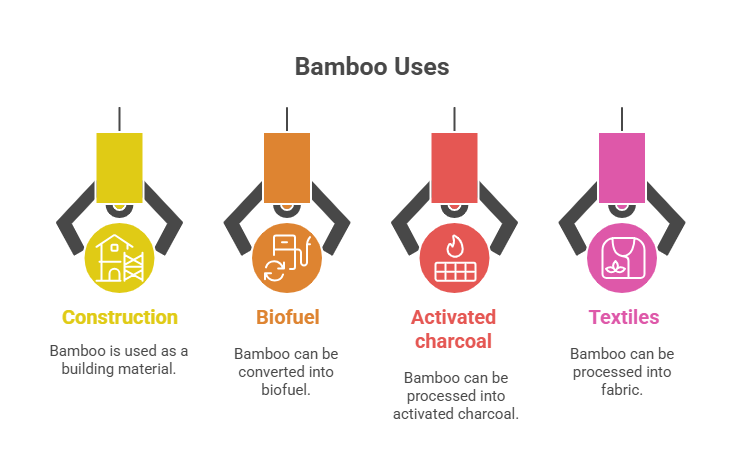
Vải sợi tre là gì?
Vải sợi tre là một loại vải dệt được sản xuất bằng cách xử lý bột tre thành sợi, sau đó kéo sợi và dệt thành vải. Có hai phương pháp sản xuất chính:
Quy trình cơ học : Tre được nghiền nát và xử lý bằng các enzyme tự nhiên để tạo thành bột giấy, sau đó được kéo thành sợi. Phương pháp này thường được gọi là "vải tre lanh", thân thiện với môi trường nhưng ít phổ biến hơn do chi phí cao hơn.
Quy Trình Hóa Học : Bột giấy tre được hòa tan bằng các chất hóa học (ví dụ: natri hydroxit, carbon disunfua) theo quy trình tương tự như sản xuất viscose, sau đó được đùn thành sợi. Mặc dù hiệu quả về chi phí, phương pháp này có thể gây hại cho môi trường trừ khi được quản lý bằng hệ thống tuần hoàn khép kín để tái chế hóa chất.
Sự Khác Biệt Với Các Loại Vải Khác
so Với Cotton : Tre sử dụng ít tài nguyên hơn so với cotton thông thường, mặc dù cotton hữu cơ có độ bền tương đương gần hơn về mặt tính bền vững. Để tìm hiểu thêm, bạn có thể tham khảo các bài viết tôi đã viết trước đây: Vải Bamboo và Vải Cotton: Chất Liệu Nào Phù Hợp Nhất Cho Quần Áo và Giường Tắm Của Bạn?
so Với Linen : Cả hai đều thoáng khí, nhưng vải tre mềm hơn và ít bị nhăn hơn.
so Với Vải Tổng Hợp : Không giống như polyester, vải tre có thể phân hủy sinh học và thường thân thiện với môi trường hơn.
Chất liệu này mang lại những hứa hẹn mới:
Tính mềm: Cảm giác như lớp da thứ hai. Mịn màng. Sang trọng. Sự thoải mái mà nhiều chất liệu truyền thống khó sánh bằng.
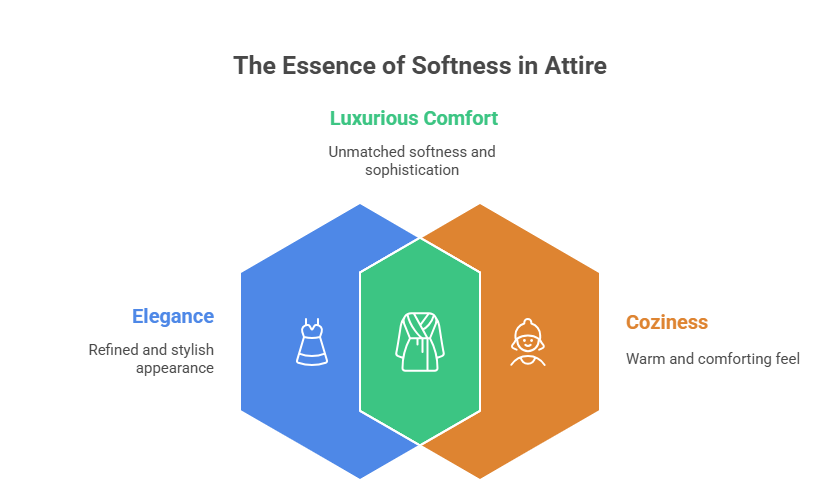
Khả năng thở: Không khí lưu thông tốt. Khả năng thấm hút mồ hôi vượt trội. Giữ mát vào mùa hè, ấm áp vào mùa đông. Không còn cảm giác bết rít khó chịu.
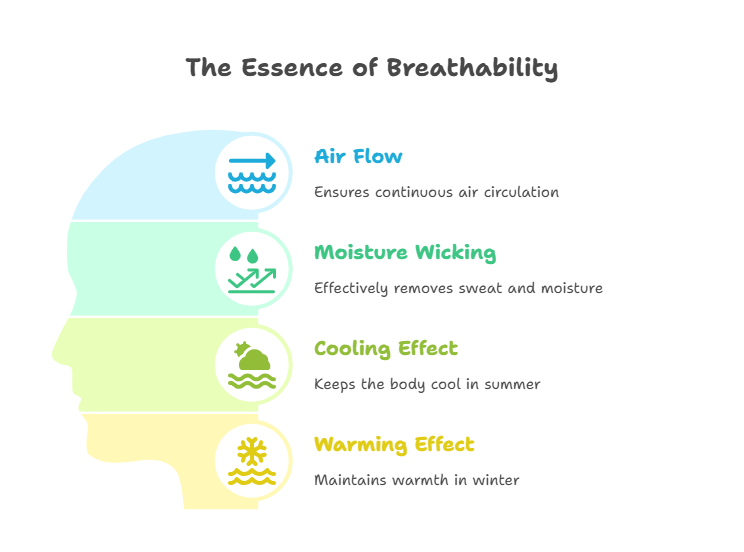
Ít gây dị ứng: Đối với làn da nhạy cảm, đây là một ân huệ. Chất liệu tự nhiên kháng khuẩn. Hạn chế mùi hôi. Tăng cường sự tươi mát.
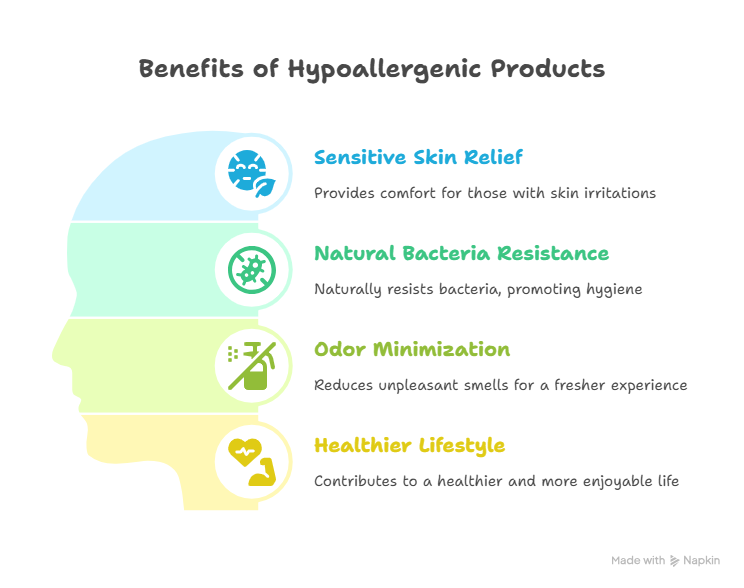
Bảo Vệ Tia UV: Lớp bảo vệ tự nhiên khỏi tia nắng gay gắt của mặt trời. Một lớp an toàn vô hình.
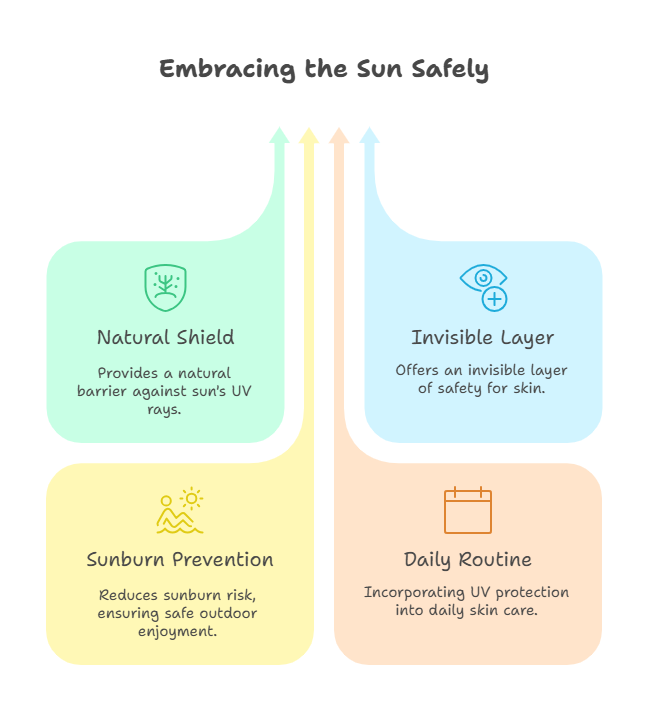
Tính bền vững: Phát triển nhanh chóng. Không cần thuốc trừ sâu. Tiêu thụ lượng nước tối thiểu. Đây thực sự là một nguồn tài nguyên có thể tái tạo. Và điều tuyệt vời nhất? Nhiều phương pháp xử lý hiện nay theo chu trình khép kín, nghĩa là ít chất thải, ít tác động đến môi trường. Thật sạch sẽ.
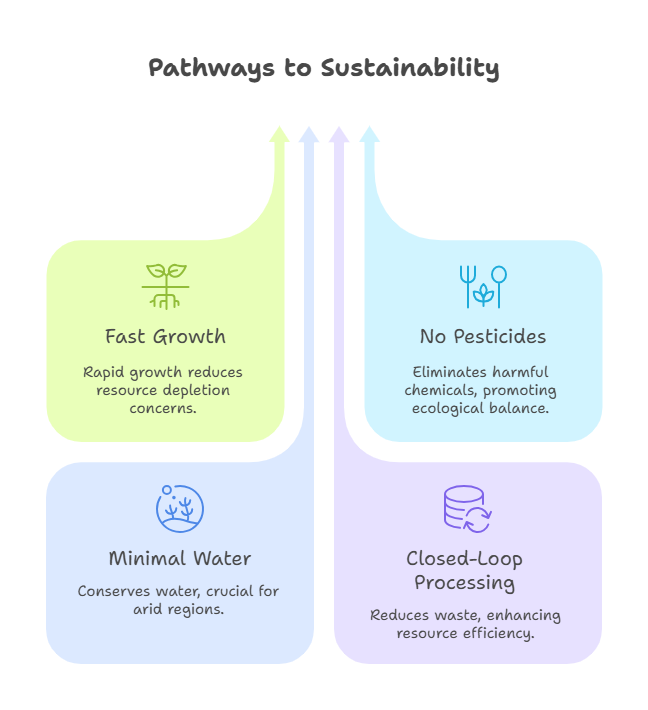
Những Lưu Ý Khi Mua Vải Sợi Tre
Khi tìm nguồn cung ứng vải sợi tre, hãy cân nhắc:
Phương pháp sản xuất : Ưu tiên các quy trình cơ học hoặc hệ thống hóa chất khép kín để đảm bảo tính bền vững.
CHỨNG NHẬN : Tìm các nhãn mác sản xuất hữu cơ hoặc bền vững làm chỉ số đánh giá chất lượng.
Tính minh bạch của nhà cung cấp : Chọn những nhà cung cấp tiết lộ thông tin về nguồn gốc và quy trình sản xuất.
Hướng dẫn chăm sóc
Để bảo quản vải sợi tre:
Giặt rửa : Sử dụng nước lạnh và chất tẩy rửa dịu nhẹ; tránh dùng thuốc tẩy hoặc chất làm mềm vải.
Sấy khô : Phơi khô hoặc sử dụng nhiệt độ thấp để tránh co rút.
Úp là : Là ở nhiệt độ thấp để bảo vệ sợi vải.
Đây không chỉ đơn thuần là tre. Đó là một lựa chọn có ý thức.
Đối với các nhà thiết kế, một bề mặt sáng tạo thời trang đạo đức.
Đối với các nhà sản xuất, một con đường hướng tới sản xuất xanh hơn.
Đối với người tiêu dùng, sự kết hợp giữa sự thoải mái, sức khỏe và sự tôn trọng đối với một loại cây cổ truyền.
Khi bạn tìm mua vải tre, hãy đặt câu hỏi. Đó là loại sợi tre nào? Viscose? Lyocell? Mỗi loại đều có một câu chuyện. Hãy hiểu rõ nguồn gốc. Tìm kiếm các chứng nhận. Hiểu rõ nhà cung cấp của bạn. Bởi vì mỗi sợi vải tre đều mang theo một phần lịch sử dài lâu, im lặng ấy, từ rừng tre cổ xưa đến sự thoải mái trong tay bạn.
Mục Lục
- Tình bạn bền vững của Tre: Lịch sử của Sự sinh tồn và Đổi mới
- Trái Tim Vương Quốc Tre, Cái Nôi Của Văn Minh
- Sự Phát Triển Lịch Sử Của Các Ứng Dụng Tre
- Thời đại Hiện đại: Ranh giới Mới của Tre trong Ngành Dệt may
- Vải sợi tre là gì?
- Sự Khác Biệt Với Các Loại Vải Khác
- Những Lưu Ý Khi Mua Vải Sợi Tre
- Hướng dẫn chăm sóc



